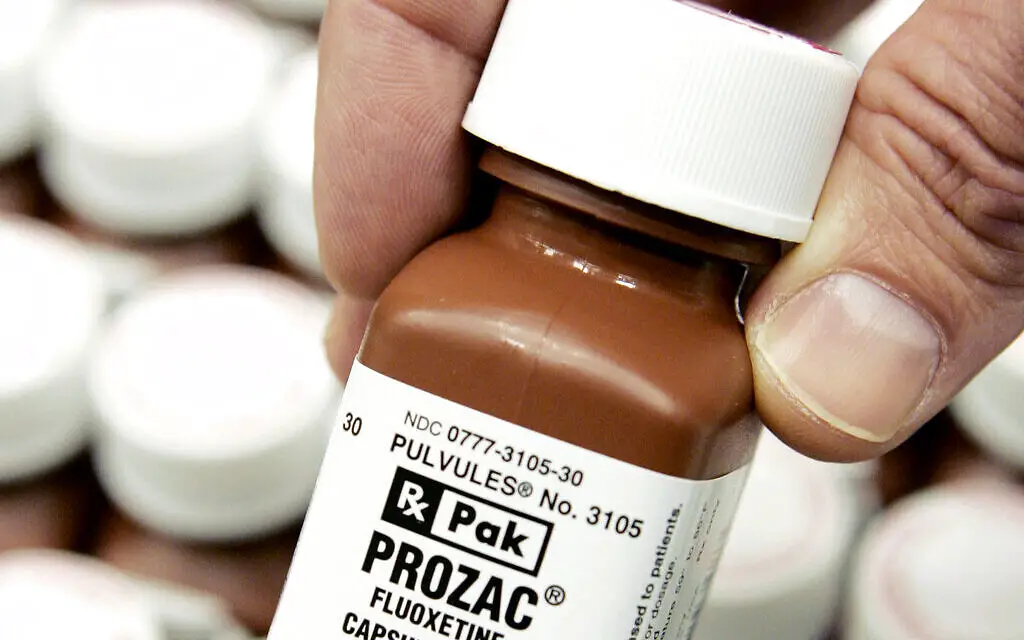Prozac (Fluoxetine)
 Photo courtesy of Times of IsraelOpens in new window
Photo courtesy of Times of IsraelOpens in new window
|
Prozac, the most common trade name for the drug fluoxetine hydrochloride, is a selective serotonin reuptake inhibitor (SSRI), an example of one of several classes of antidepressants. Fluoxetine is approved by the U.S. Food and Drug Administration (FDA) for treatment of major depressionOpens in new window, obsessive-compulsive disorderOpens in new window, panic disorderOpens in new window, and bulimia nervosaOpens in new window. It is widely prescribed in the United States and oher parts of the world.
The discovery of fluoxetine began in 1970, when Bryan MolloyOpens in new window and Robert Rathbun of Eli Lilly LaboratoriesOpens in new window began work with a compound, 3-phenoxy-3-phenylpropylamine, which is molecularly similar to an antihistamine (diphenhydramine) known to have some antidepressant effects (Wong, Bymaster, & Engleman, 1995).
Molloy and Rathbun produced a drug that was a selective norepinephrine reuptake inhibitor (SNRI).
- Norepinephrine is a chemical messenger in the brain that sometimes malfunctions in cases of depression.
- Reuptake involves reabsorption of the neurotransmitter; the medication inhibits reuptake, recycling, and making more norepinephrine available for use.
David Wong of Eli Lilly worked to find a similar chemical which would operate as an SSRI because serotoninOpens in new window is often implicated as a neurotransmitter that malfunctions in depression. By 1972, fluoxetine was developed.
Although it was not the first SSRI created and released on the market, it had fewer side effects than earlier SSRIs; two early SSRIs were withdrawn from the market because of their side effects. Eli Lilly implemented highly effective marketing, and therefore fluoxetine is often perceived as the first SSRI. Fluoxetine was sold in Belgium in 1986 and was approved in the United States by the FDA in 1987.
Use of fluoxetine may be associated with side effects, most commonly nausea, insomnia, drowsiness, anxiety, nervousness, weight gain or loss, and tremor (Prestone, O’Neal, & Talaga, 2008). Patients have reported that another side effects, akathissia (restlessness and an inability to remain motionless), caused them to feel suicidal (Rothschild & Locke, 1991). Sexual side effects may occur.
Taking fluoxetine during pregnancy may increase the risk of prenatal complications and could have adverse effects on newborns (Preston et al., 2008). It is also known that fluoxetine passes into breast milk, but research is lacking into its effects on nursing infants. All potential risks should be discussed with a doctor.
Serontonin syndrome is a potentially lethal condition that results from toxic levels of serotonin in the central nervous system. Serotonin syndrome can be caused by combining antidepressants with each other or with some opioids, antimigraine medications, stimulants (e.g., amphetamines, cocaine), empathogens (e.g., MDMA or Ecstasy), some herbs (e.g., St. John’s wort), and various other medications and over-the-counter products.
Symptoms of serotonin syndrome may include rapid heart rate, sweating, shivering, dilated pupils, tremor or twitching, muscular rigidity, elevated temperature, confusion, agitation, delirium, hallucinations, coma, or death. Combining antidepressants and alcolhol is not advisable; alcohol, a depressant, can worsen clinical depression and increase the toxicity of some SSRIs.
In 2004, the FDA announced that use of Prozac may increase the risk of suicideOpens in new window attempt in children. This official statement followed years of discussion regarding potential suicidality or homicidality associated with taking antidepressants such as Prozac.
The FDA’s statement, however, is controversial. Mental health practitioners and scientists such as psychiatrist Peter Kramer, author of Listening to Prozac (1997), heralded the benefits of Prozac and argued that side effects are minimal.
Conversely, others, such as psychiatrist Peter Breggin—author of The Anti-depressant Fact Book (2001)—agree with the FDA and make even stronger claims, arguing that psychiatric medications are used much too frequently, with disastrous results.
For some people, this controversy brings up questions about what it means to be a human being: are we solely biological creatures? Does the effectiveness of antidepressants and other psychoactive drugs imply that we lack free will or a soul? This controversy is likely to continue for years to come.
- Breggin, P.R. (2001). The anti-depressant fact book: What your doctor won’t tell you about Prozac, Zoloft, Paxil, Celexa, and Lavox. Cambridge, MA: De Capo Press.
- Kramer, P.D. (1997). Listening to Prozac: The Landmark book about antidepressants and the remaking of the self. New York: Penguin.
- Preston, J.D., O’Neal, J.H., & Talaga, M.C. (2008). Handbook of clinical psychopharmacology for therapists (5th ed.). Oakland, CA: New Harbinger.
- Rothschild, A.J., & Locke, C.A. (1991). Reexposure to fluoxetine after serious suicide attempts by three patients: The role of akathisia. Journal of Clinical Psychiatry. 52, 491 – 493.
- Wong, D.T., Bymaster, F.P., & Engleman, E.A. (1995). Prozac (fluoxetine, Lilly 110140), the first selective serotonin uptake inhibitor and an antidepressant drug: Twenty years since its first publication. Life Sciences, 57, 411 – 441.

